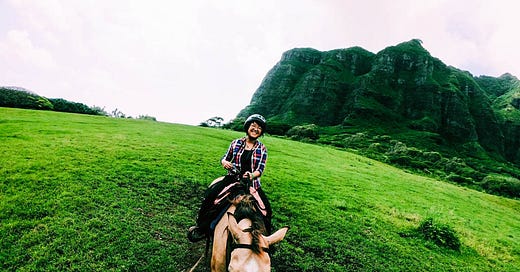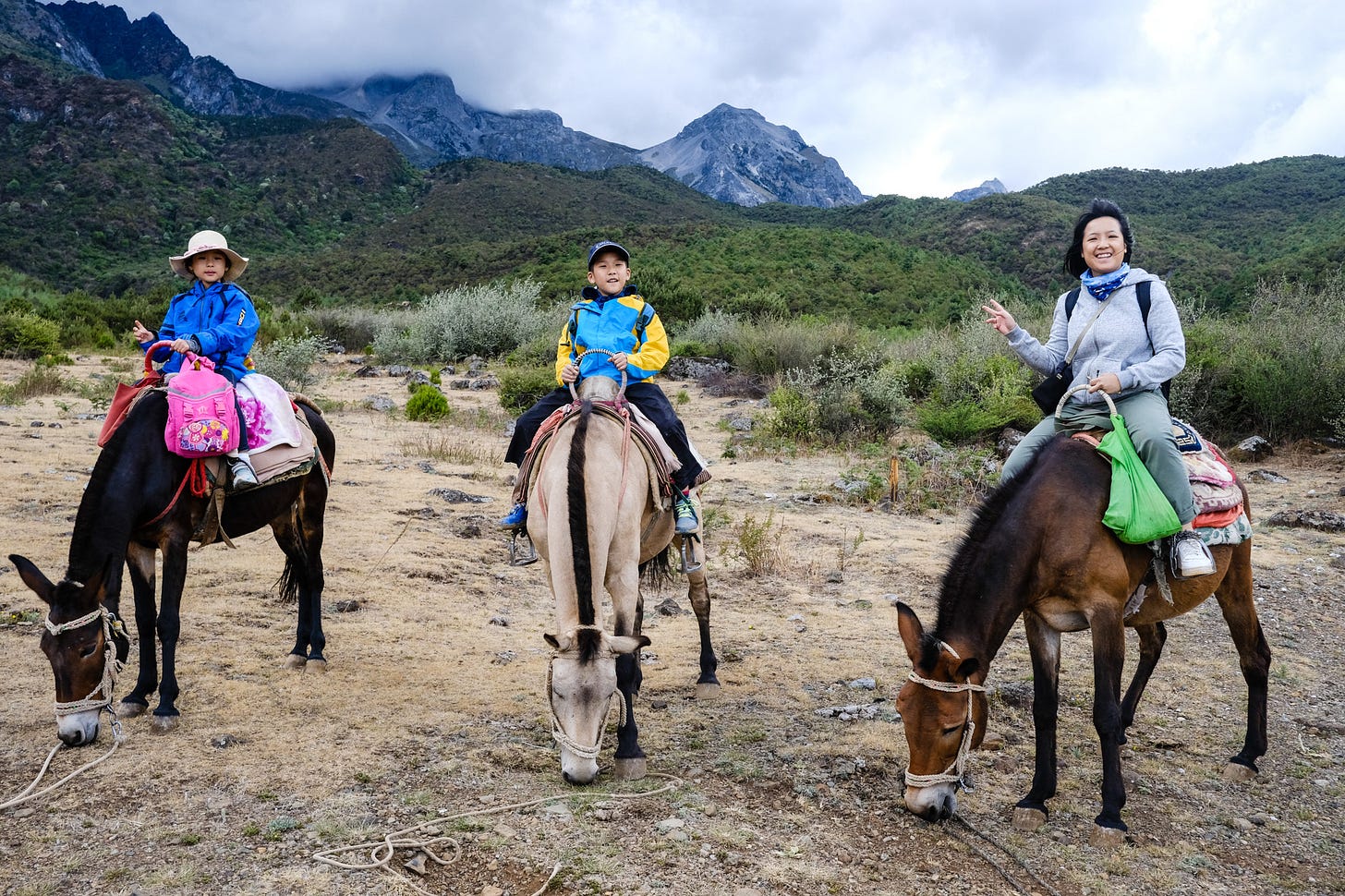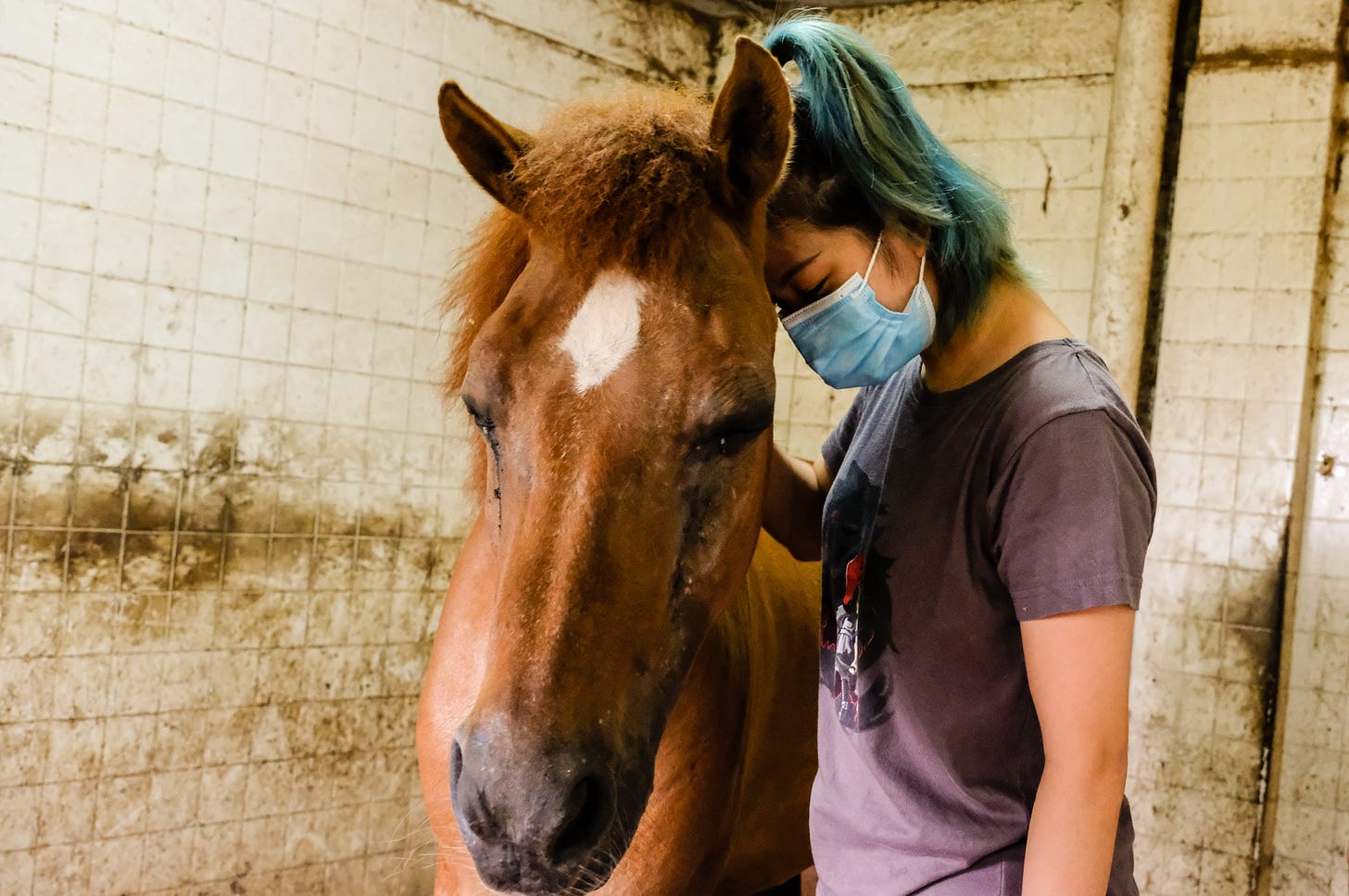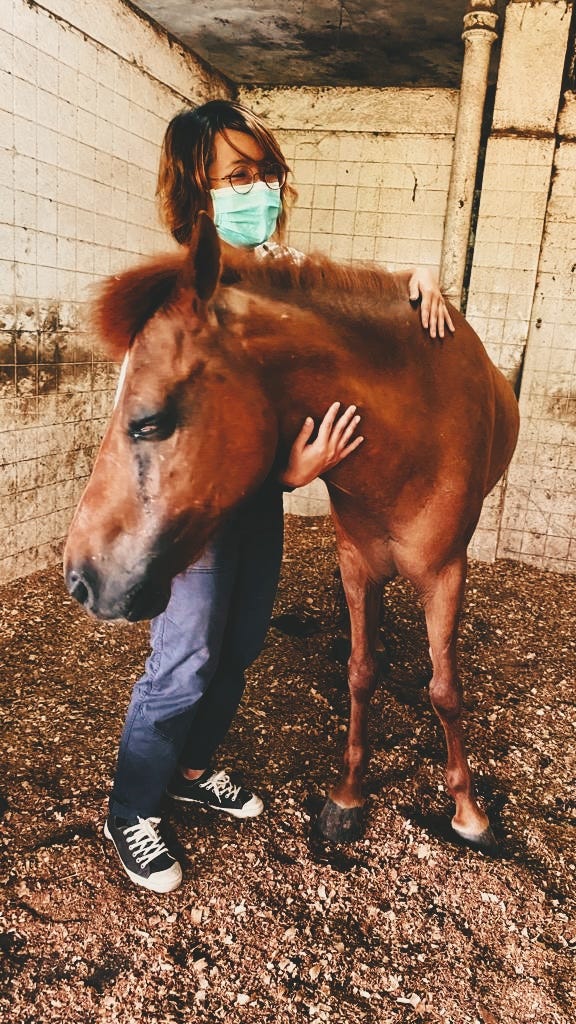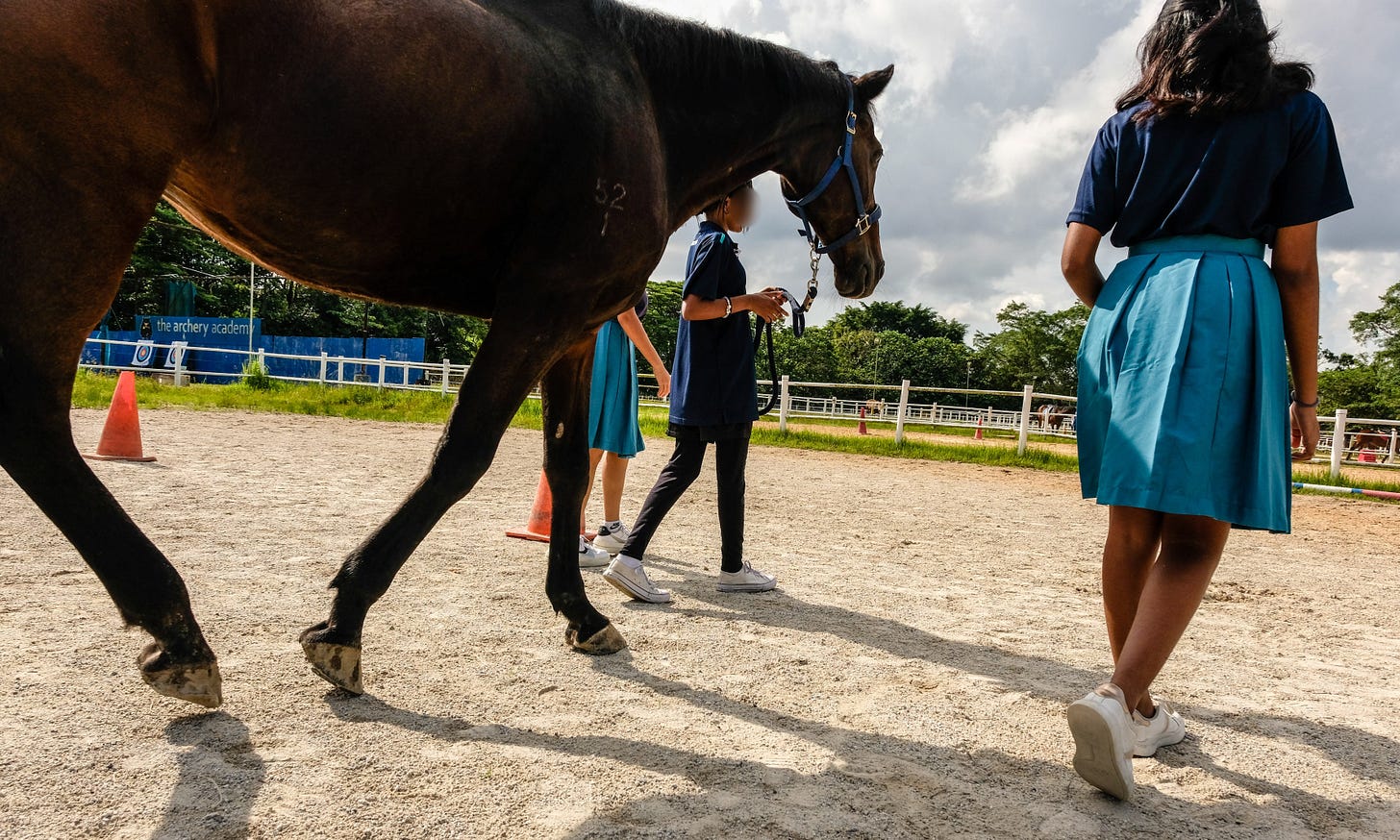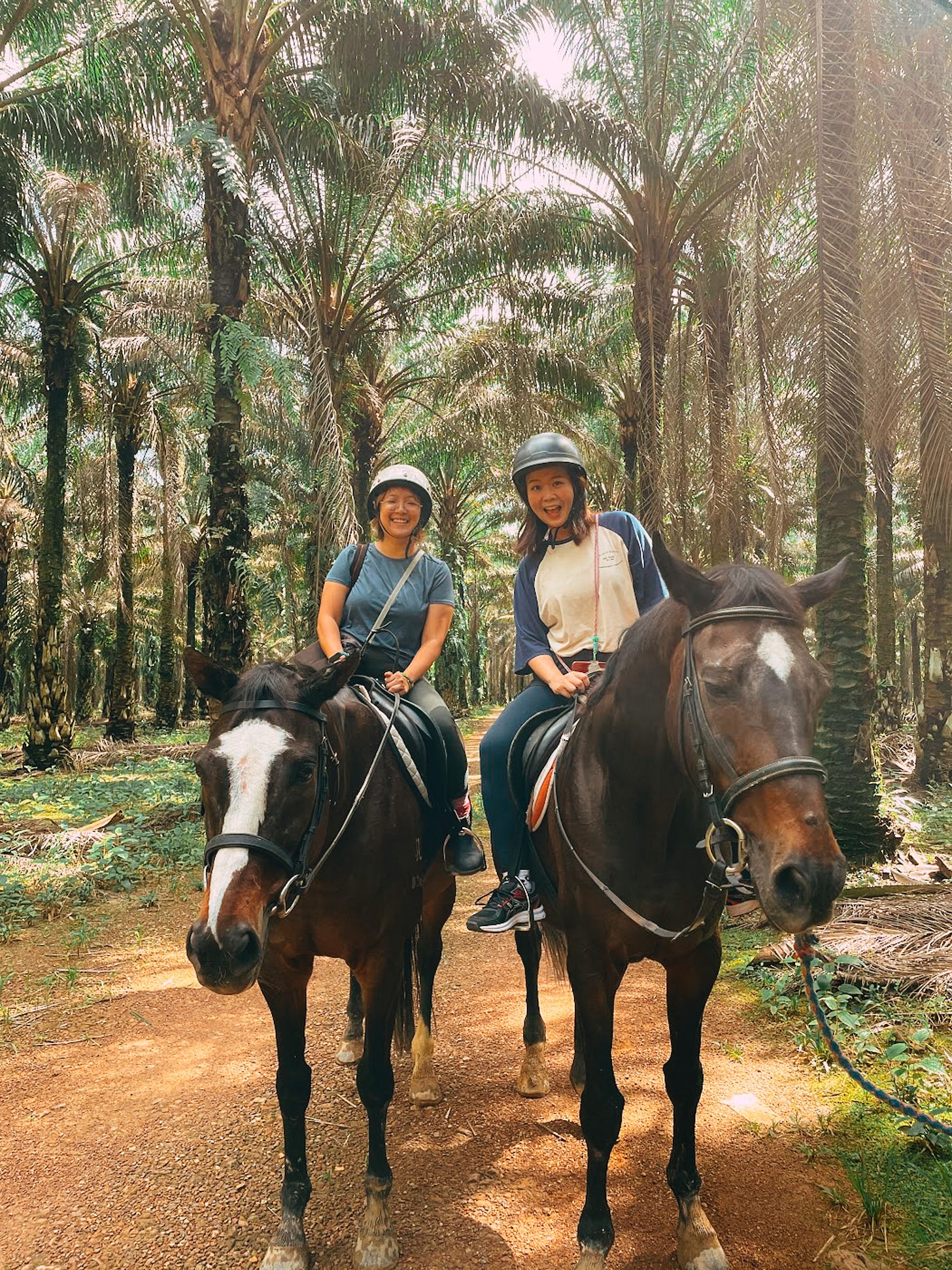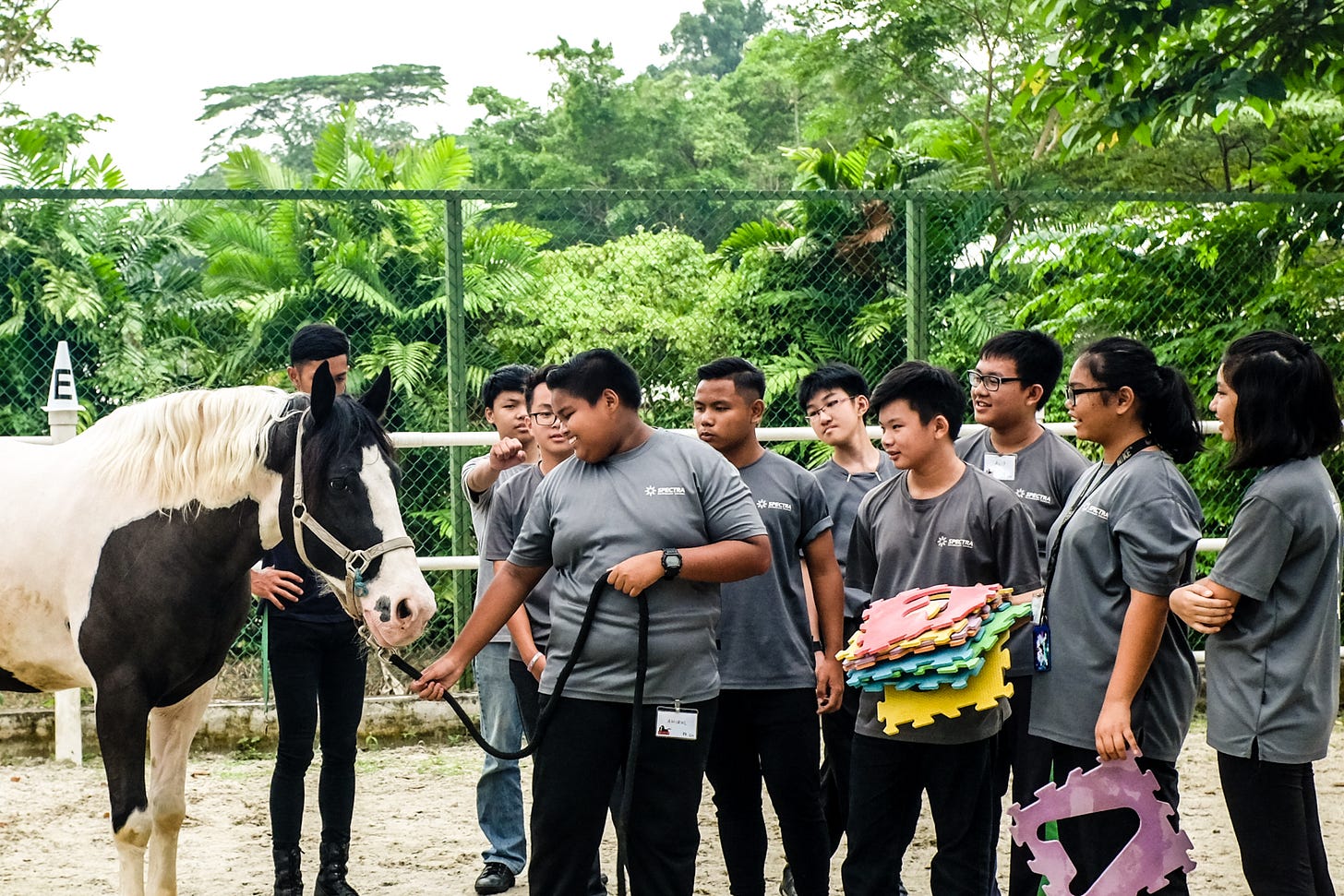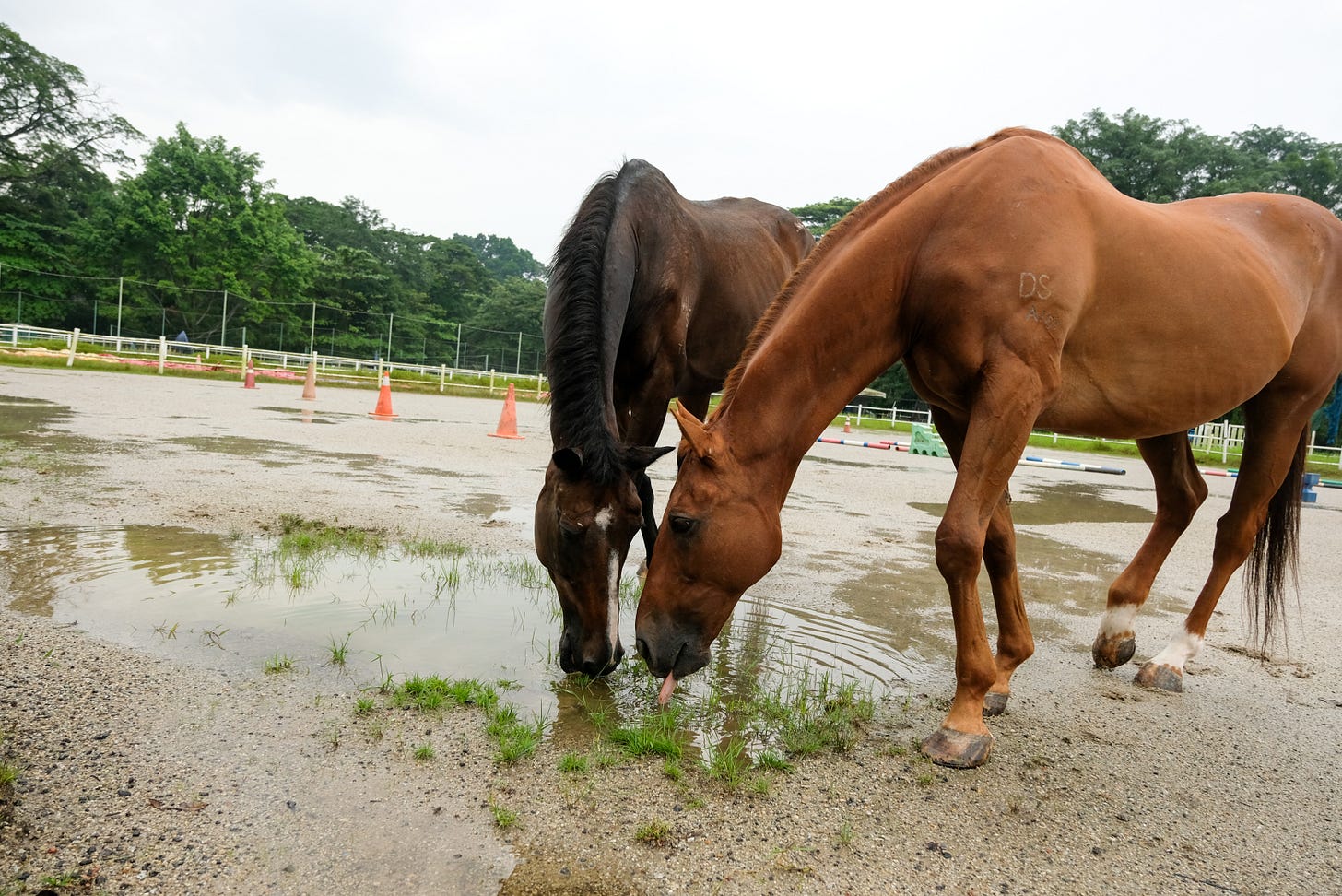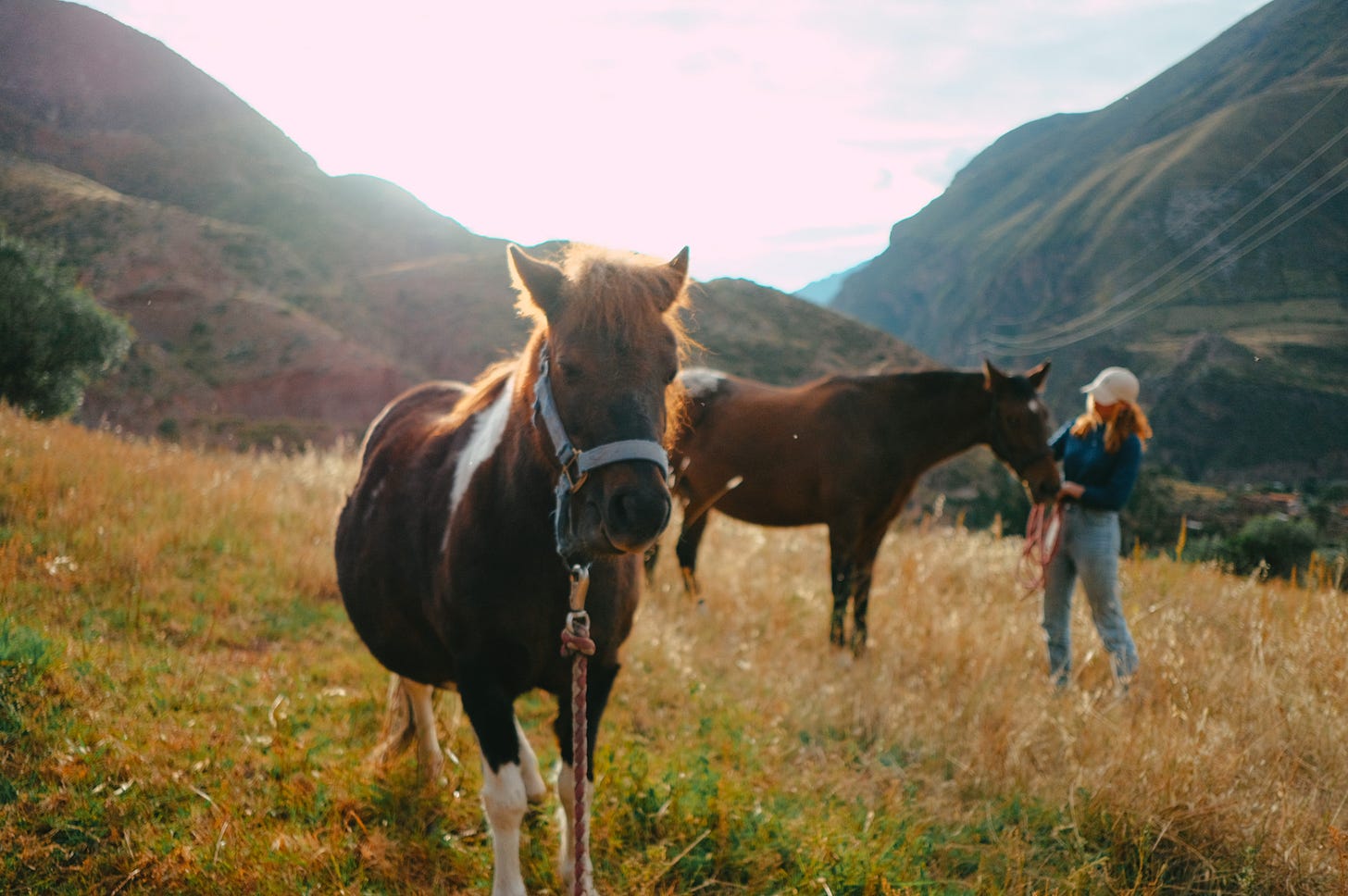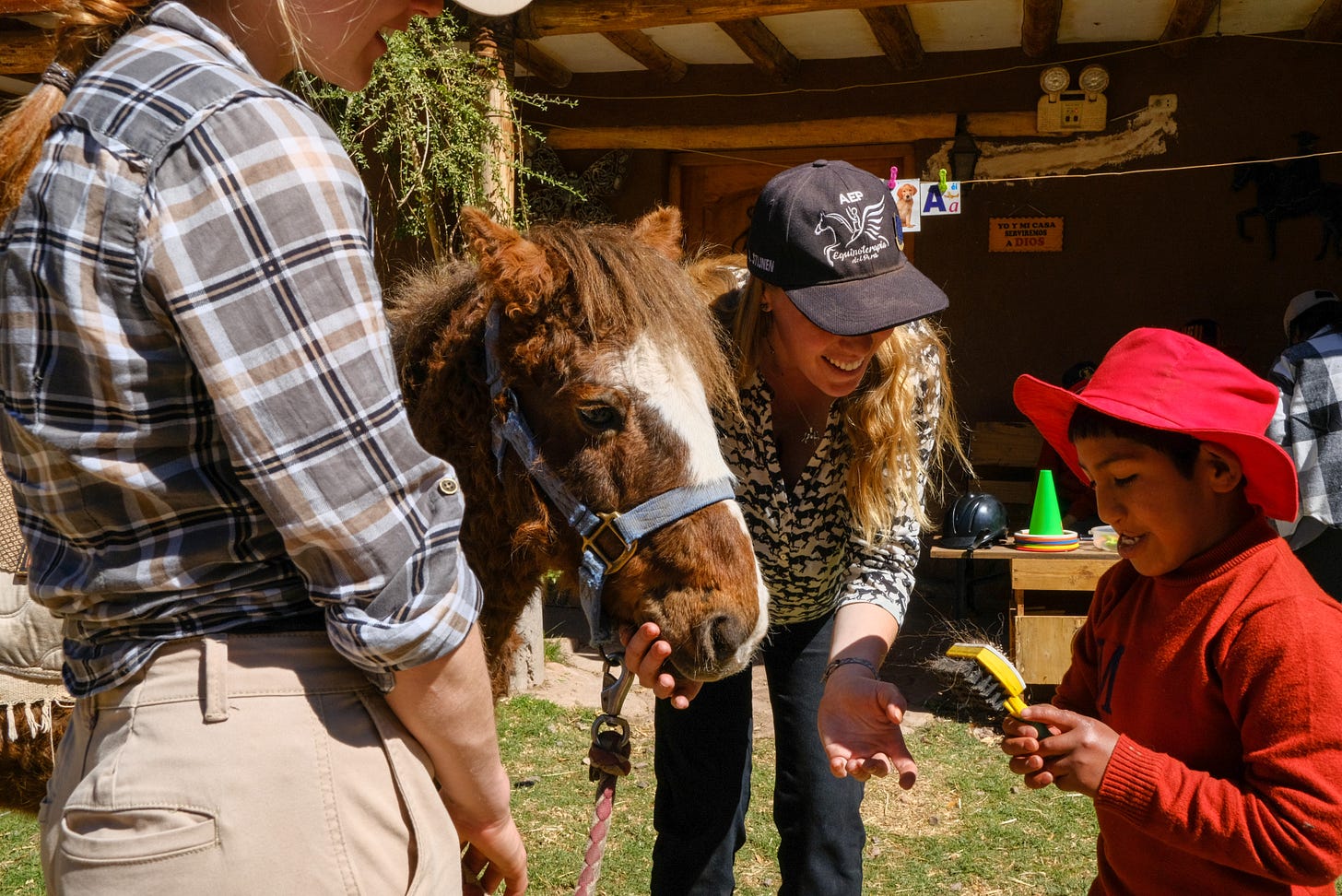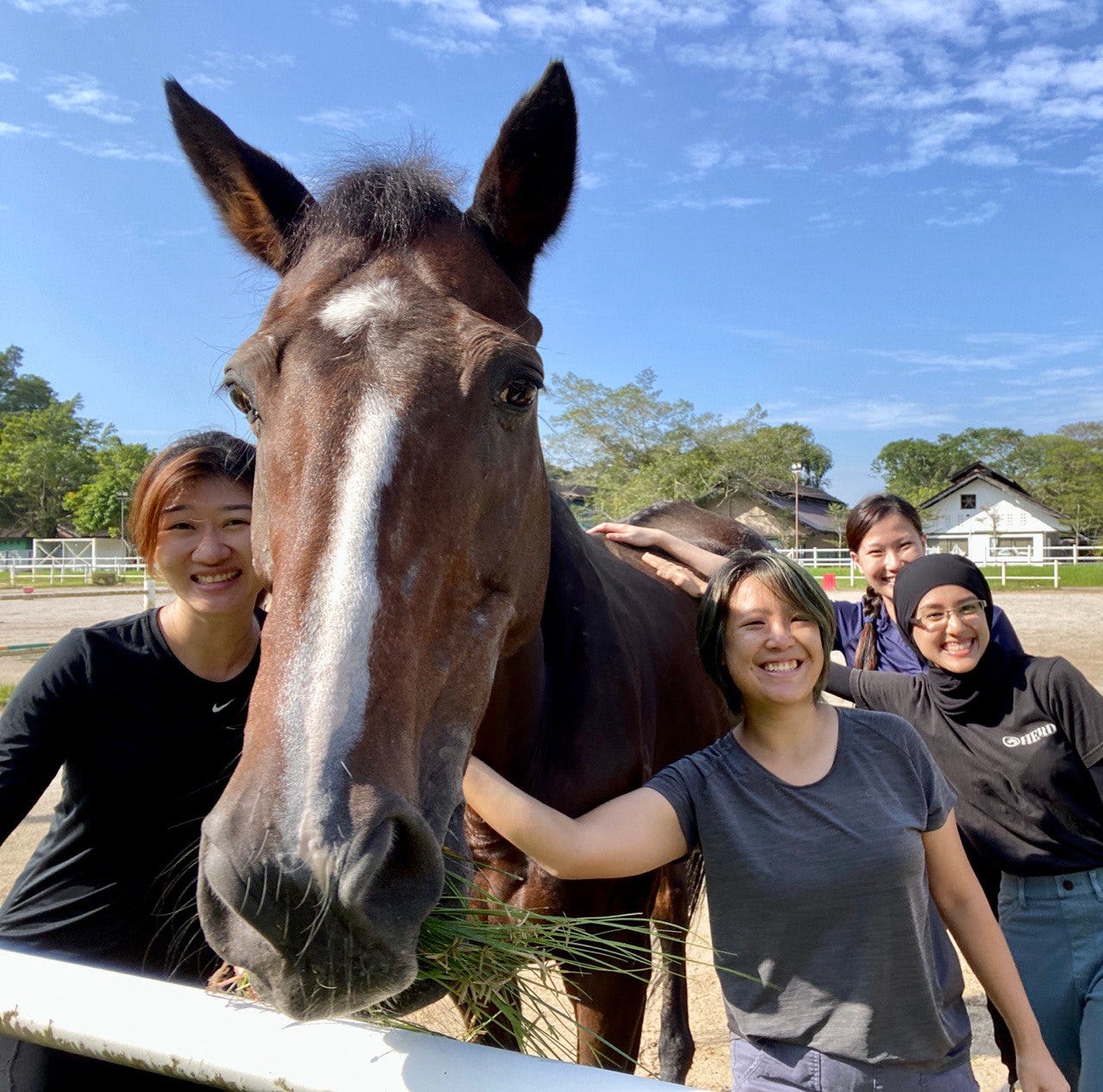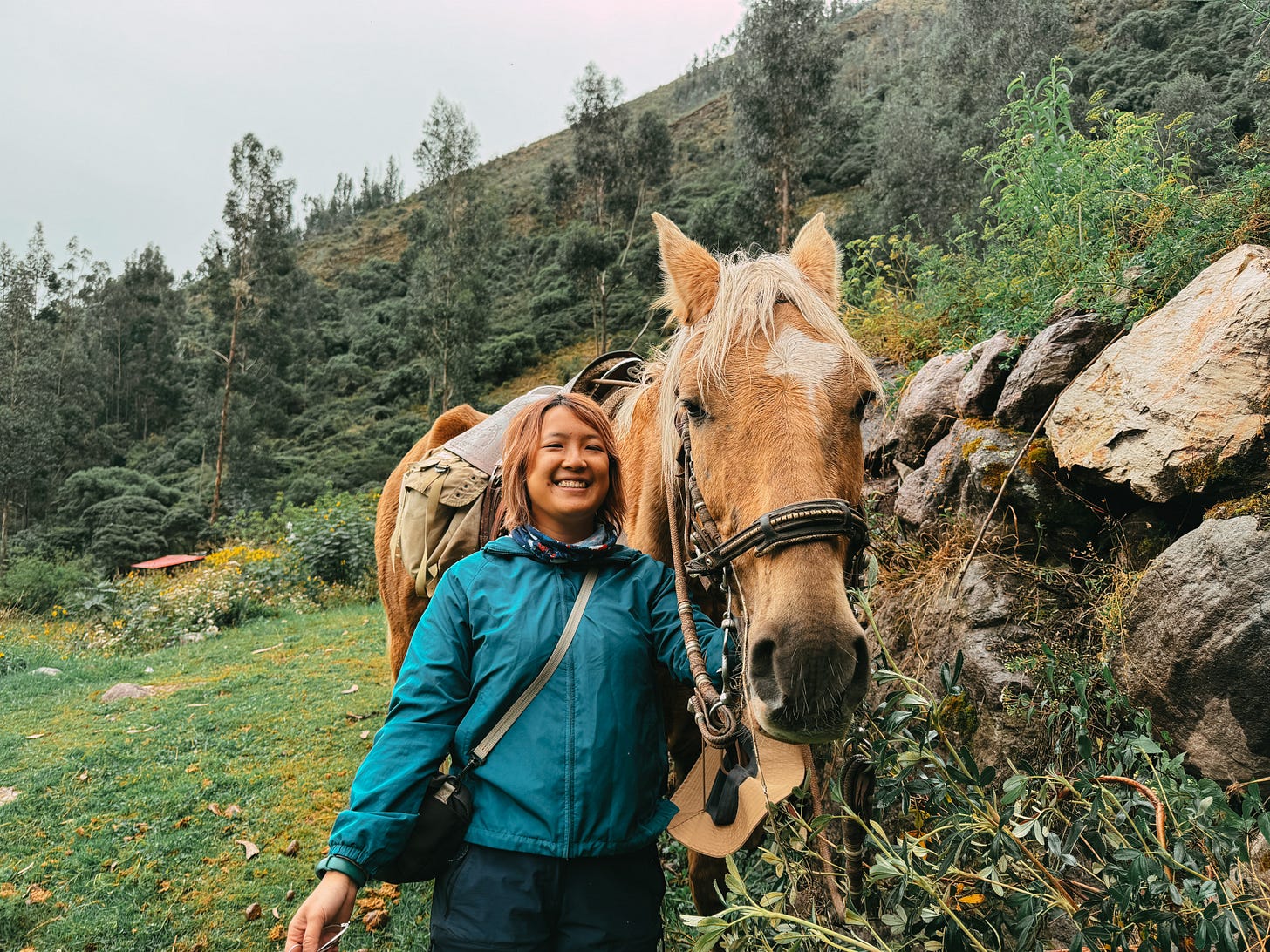Lessons I learnt from being around horses
Coming from land-starved Singapore, working with horses is both rare and a precious gift
For as long as I can remember, I have always nursed a love for horses, without really knowing why.
During my childhood, my father often drove past the Singapore Polo Club in Thomson and would stop to let me interact with the horses at the stables. My bedside companion was a horse plushie I called Blackie/Brownie, which I had found in a store while on holiday in Shanghai during my early teens. It wasn’t conventionally cute and had a mournful look in its eyes, but I loved it anyway.
During a school work attachment program with the Singapore Zoo, I was assigned to KidzWorld and tasked with caring for mischievous falabellas (a miniature horse breed), including a shaggy, raven-haired falabella named Elvis. Though it was only a short one-week experience, those memories are still firmly etched in my mind.
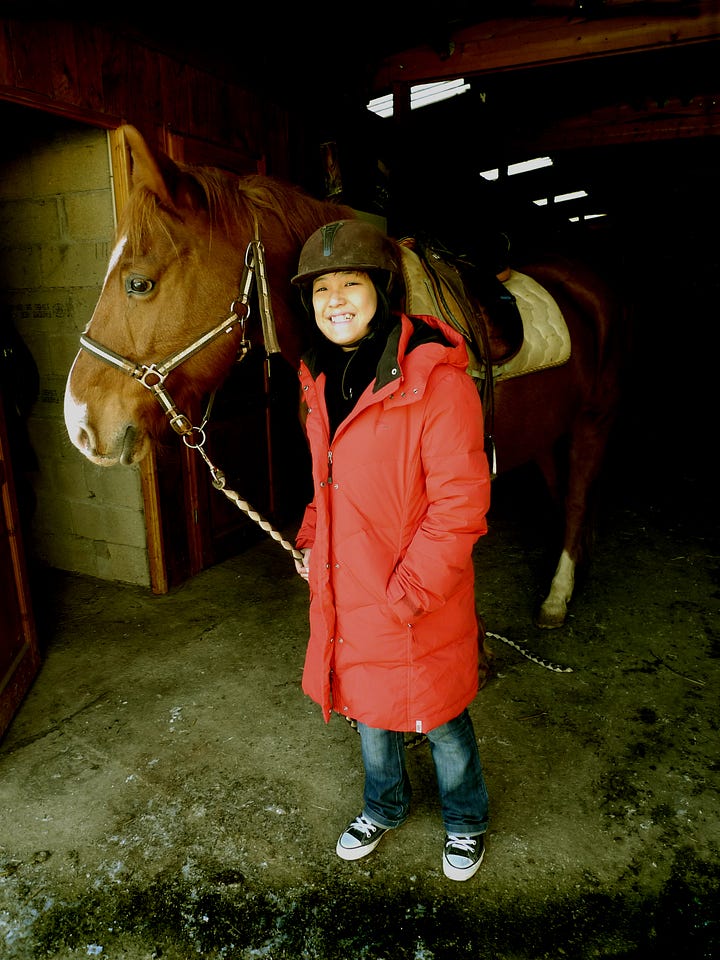

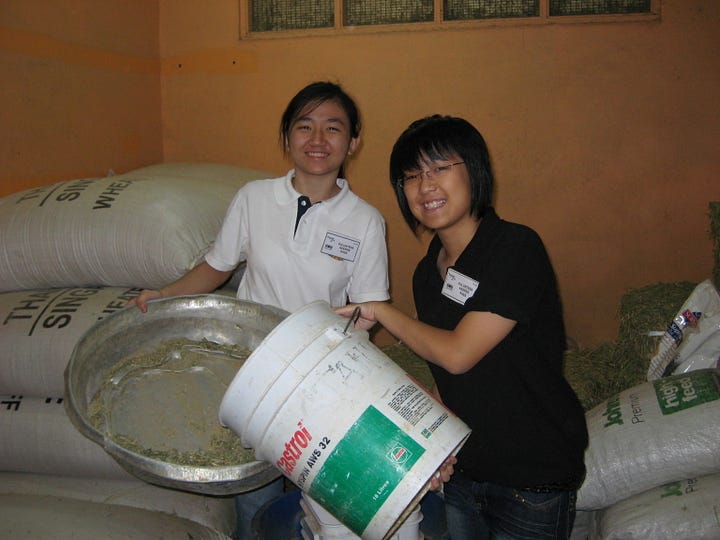

During my travels, I seized every opportunity to ride, embarking on increasingly longer rides in destinations such as Indonesia, France, Hawaii, Yunnan, Kazakhstan, and Peru.
In 2022, during a period of debilitating sadness, I was desperate to find alternative modes of therapy when talk therapy didn’t seem effective. I pursued it the only way I knew how: by pitching a news story about the growing awareness of mental health and the rise of niche animal therapies in a story for the Southeast Asia Globe.
This led me to connect with HERD Singapore, a relatively new social enterprise which offers equine-assisted intervention. The team at HERD has worked with a variety of worked with a range of beneficiaries, including schools, orphanages, family service centers, and nursing homes. They bring combined expertise in social work, counseling, special needs, stable operations, natural horsemanship, program development, and equine-assisted learning facilitation.
Driven by a desire to integrate horses more closely into my daily life, I joined Herd as part of their inaugural group of volunteers.
Every chance I got, I traipsed down to the stables at Bukit Timah Turf City. The mad crowds and suffocatingly dense cityscape fell away, replaced by open pastures, stillness, and lush foliage. I could finally breathe again.
The first thing I noticed was how quiet the stables were. Unlike most animal shelters, which often left me overwhelmed by the smells, sounds, and chaos, the stables were blissfully peaceful. I learned the names of different horses, took them out on walks, groomed and bathed them, mastered the art of cleaning their hooves, and watched them roam freely in the pastures. Another fascinating aspect I discovered was that, unlike most animals that are typically food-motivated, horses are driven by trust. Despite their incredible strength, they remain remarkably gentle with humans.
Soon, it became my happy place.
As part of my journey to deepen my understanding of horses and equine therapy, I turned to the TV show Heartland. It’s a Canadian family drama television series which follows sisters Amy and Lou Fleming, their grandfather Jack Bartlett, and Ty Borden through the highs and lows of life at their horse ranch in the fictional town of Hudson, Alberta.
The show offers valuable insights into various aspects of horse management, from handling different equine personalities to understanding their physical and emotional health. It also combines heartfelt storytelling, emphasizing on the importance of community, family support, and personal resilience.
Living in urban Singapore, people are often surprised to hear that there are horses here. Horse riding is perceived as impractical, expensive, and reserved for the elite.
Now, after working closely with horses, I can finally articulate why they hold such a special place in my heart. Caring for these horses has helped me with my own mental health struggles. Their sensitive nature and gentle energy grounded me.
I hope to capture the lessons distilled from these horses here, more for myself than anything else.
Why Horses are Great as Therapy Animals
One of the very first things I learned is that horses are prey and herd animals, which means they are extremely sensitive to their environment. They have a strong emotional sense and use this sense as a survival tool; they feed off and respond to other horses in the herd. If one horse in a herd is scared, the others will become frightened. In the same way, horses act as an emotional mirror for humans.
Horses can sense and reflect our emotions and energy levels, even those we are not aware of ourselves. They are acutely attuned to the smallest changes, like tone of voice, body language, behaviors, and emotions. Because of these qualities, horses are said to help people heal from a variety of psychological issues.
The horses in HERD’s program showcase the right temperament and willingness to work with clients. But most importantly, HERD has a unique philosophy: "You don’t choose the horse, but the horses choose to work with you in a mutually beneficial relationship." I got to meet Stardom, a visually impaired horse, poster boy Willis, old Don, Disney, and Snowy (who has skin problems), all of whom seemed to want to connect and were interested in human interactions.The Power of Healing
The first time I shadowed HERD’s programmes in this story for the Southeast Asia Globe, I witnessed first-hand the horses’ healing power.
On a cool Sunday morning at the horse stables, with the rain drizzling softly outside, I watched as widow Lily Tan tentatively caressed blind horse Stardom’s mane. She had always been afraid of animals, and this was her first time interacting with horses.
The meditative motion reminded her of how she stroked her late husband’s hair during his last days of fighting leukemia in the hospital. Her husband, who loved the outdoors and camping, had passed away a month ago, and Tan’s grief was still raw. The tiny horse seemed to sense the weight of her sorrow and leaned its body gently against her, as if giving her some support.
“I don’t understand why it keeps coming near me. Maybe it wants a cuddle? It must be so comfortable to want to lean against me,” she said.
It was such a beautiful moment to witness. Over the course of my volunteering, I was able to see how horses brought out the softer side in a group of youths at risk, inspired a sense of confidence in children living with cancer, and brought comfort to bereaved pet owners.
3. Building My Own Assertiveness and Confidence
Naturally, it can be daunting to lead an animal that is so much bigger than me, but working with horses reiterated the importance of being sure of myself.
When walking Disney, I learned that I have to be very clear about where I want him to go. Just like driving, I need to think three steps ahead, steer the reins confidently, and he will follow my lead. Show no hesitation! I’m the boss, not the other way around. If he gets distracted or stops suddenly, I need to get him to focus and move again. (E.g tapping on his leg, facing forward in a confident stance and pulling his reins forward firmly) When we’re walking in sync, it feels amazing.
4. A Mutually Beneficial Relationship
The first time I got to walk blind Stardom, I was warned to be extra careful because of his condition. I could tell how excited Stardom was to get some exercise, but then he started to pick up his pace and walk faster and faster.
He began to lean against me, needing reassurance that I was there to guide him, and pushed me towards the wall, which could be potentially risky if I was not careful. I held my stance firmly and kept one hand on his back the whole time, reassuring him that I was there. Later, while grooming and bathing him, Star nuzzled me affectionately, as if wordlessly thanking me for the walk. What a sweetheart.
5. The Importance of Being Focused
One time, I was tasked with grooming Stardom. I found him sitting down and chilling in his stable. But the thing is, I had no idea how to get him to stand up.
I summoned up my most authoritative voice, mustered a strong stance, and commanded, "Stand up!" It seemed so silly, but I had been told that horses would sense your energy. At the same time, I started to place my hands on his back and rocked him back and forth, just like how you would shake a grumpy teenager awake. Stardom ignored me and kept sitting. It must have looked so ridiculous, but I kept at it for ages, determined to see it through. I was on the verge of giving up, but finally, Star stood up!
6. Boundaries and Communication
I got so excited about greeting Stardom that I hugged his neck tightly, and he turned around and bit me. I was so sad! I guess I learned that I have to temper my enthusiasm and respect his space.
Because he’s blind, I also have to constantly chat and communicate with him so he can sense my voice and know where I am in the space, preventing any rude shocks.
7. Horses Bring Out a Different Side of People
Last year, I had the chance to shadow a six-session intervention program with youths at risk, a small group of teenage girls who were perceived as the school’s troublemakers. They were often seen as rowdy and rebellious in class and constantly skipped school. But here in this nurturing environment, the girls were lovely, engaged, and respectful of Willis and Dart, taking their time to observe the horses carefully. The counselor got visibly emotional afterward. “I always knew they had this side of them, but this is my first time seeing it,” she told us.
The girls drew interesting parallels to their own situations. “I identify with Dart because he’s not the typically popular one. He’s more guarded around people, he takes time to trust, and he has wounds, just like me,” one girl said. Another observed, “He’s biting the gate constantly because he feels anxious, bored, or depressed.”
8. Stop, Think, Act
In one session, we discussed the principle of ‘Stop, Think, Act’ with horses:
Stop: Pause what we are doing and breathe to calm down.
Think: Consider what we are doing next and whether our actions will impact ourselves or others.
Act: Act responsibly, respectfully, and safely.
One week later, the girls reported how they applied this principle to their daily lives. For J, when her grandpa called her to wake up from her nap to join him for dinner, she did not ignore him as she usually did. Instead, she took a deep breath, practiced patience, and told him she wanted to rest. She was conscious of not hurting his feelings and wanted to acknowledge his presence. For C, instead of flaring up and getting angry at an annoying boy, she pictured his face as a horse. Then she started laughing, which completely confused the boy. Every time she saw him, she started to find him funny rather than irritating.
Just one shift in perspective can change someone’s actions! By the end of the program, the girls vowed to attend school more regularly and cried when saying goodbye to the horses. To us, it may seem like a small initiative, but it may have a far deeper impact than we realise.
9. Nature As Classroom
Last year, fellow HERD volunteer Ting and I sought out private riding lessons at Nadi Equestrian Centre in Malaysia, just a 20-minute drive from the checkpoint.
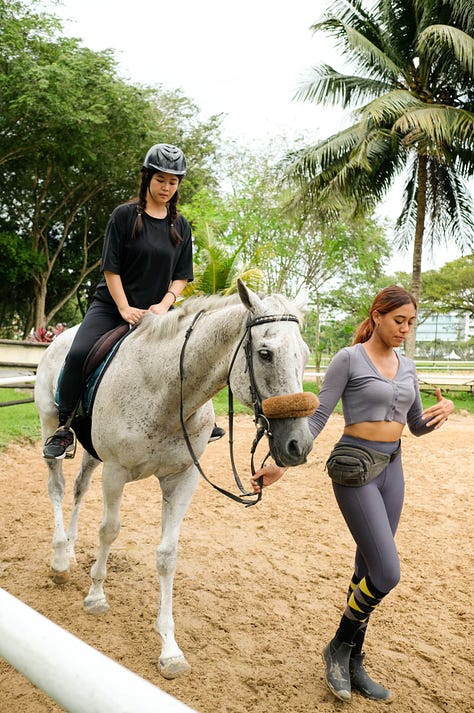
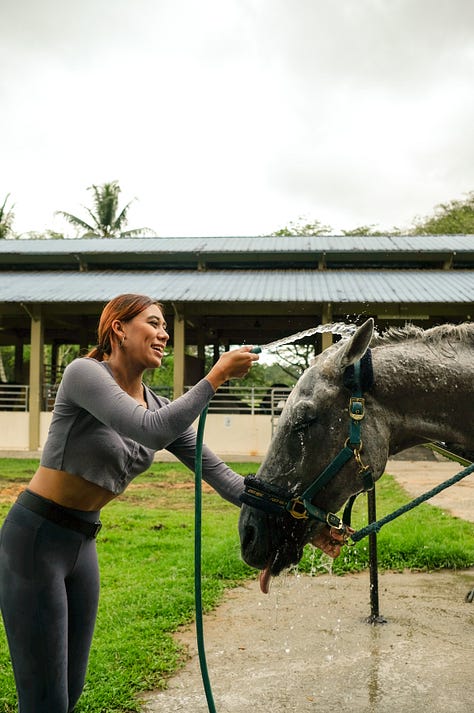

My riding coach Aly is based in Singapore, but makes the trip to JB frequently to see her beloved horse Storm, who she houses there as the rates are cheaper. I learnt how to do a sitting and standing trot, even with my eyes closed!
Aly told us about Riders Resort, which I wrote about in this article for Channel NewsAsia.
This wasn’t your usual Johor Bahru itinerary – none of your usual sights of JB Sentral, hipster cafes or massage spots. Instead, I’m situated in the small town of Kulai. An hour’s drive from Woodlands Checkpoint, the town is replete with old-school eateries and located near Gunung Pulai’s lush rainforest where civet cats, tapirs and monkeys roam.
In January, I booked a weekend stay at Riders Resort, seeking out the country life with horses and the wide expanse of nature. Home to riding trails, equestrian facilities and a sprawling colonial-style mansion, Riders Resort has long been a refuge for off-the-beaten path travellers like myself.
Since its inception, Riders Resort has subscribed to the ethos of nature as a classroom and has hosted many international school camps from both Malaysia and Singapore.
For instance, camp days are filled with activities such as horse management, jungle trail rides, and horse games like musical chairs on horseback. The children also learn to bake with the resort’s chef and receive medals and awards for the cleanest room and best-decorated horseshoe. These activities aim to build team spirit, independence, responsibility, improve focus, and nurture a love for animals and nature.
Owner Janet Yeo tells me, “The kids come here and forget everything else. They do things they won’t normally do, like feeding, bathing the horse, or cleaning the dung. You’ll be amazed at how they develop this love for these majestic animals.”
Over the two days we spent there, time seemed to unspool in a lazy fashion. I met two young Swiss girls taking a riding lesson in the ring. I marveled at how different their childhood was compared to most Singaporean children. Instead of burying their heads in assessment books indoors, theirs was a life where they could roam free in the outdoors, without a parent hovering over their every move.
Elsewhere, I had the chance to observe youth programmes run by the charity Equal-Ark, which I detailed in this story for TodayOnline.
At Spectra Secondary School—a specialised school for students in the Normal (Technical) stream, focusing on vocational training— all Secondary Two students participate in equine-assisted learning for 15 weeks as part of their curriculum.
For instance, in Equal-Ark’s signature “Cross the River” horseplay game, students work as a team to guide a horse across a make-believe river. This activity helps students develop socio-emotional competencies. They learn to be more self-aware of their movements and reactions, build their self-esteem, social awareness, and confidence, and embrace values like perseverance.
A student I interviewed shared that he was once afraid to get too close to the horses for fear they might bite. He now understands them better and realizes that they have feelings too. Through the experience, horses have taught him to be calm, patient, and understanding.
10. Horses Have Funny Moments too
Things are not always as they seem. If you see Mr. Cool and Mustang together in the stables, you might think they are the best of friends. But if you observe closely, you’ll notice that Mr. Cool likes to hog all the attention and prefers keeping Mustang confined to one corner.
One day, I purposely mussed up Mr. Cool’s mane to make him look less cool, which he quickly shook off. Guess it’s not cool enough for him :P



Another pretty cool thing I discovered is that if you scratch a horse in the right spot, it gets so shiok that its lips start trembling and it looks like it’s smiling!
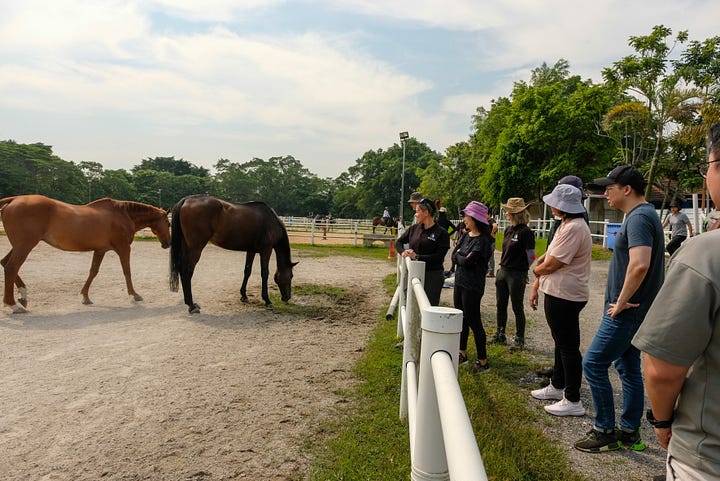

11. The Realities of Daily Life on a Horse Ranch
In May this year, I completed a three-week volunteer stint in Peru with Worldwide Vets. I had the chance to experience life at Hacienda del Chalan, a local family’s horse ranch in the Sacred Valley, hosted by Yojan and his Dutch wife Karina. It was surreal to wake up each morning to the sight of horses and mountains, deeply inhale the fresh mountain air, and walk among the horses.
The ranch is home to about 20 horses, with Peruvian Paso horses used for trail rides and ponies for therapy with children who have special needs. It also has an eager Bernese Mountain Dog named Oso, a tiny puppy named Spot, along with many cats, rabbits, guinea pigs, and ducks.
Here, the animals reign supreme; their needs come first, and humans come second.
Our day typically starts at 6 a.m. with morning feeding for all the animals on the ranch.
My favorite task is making the rounds in the backyard, trundling a heavy wheelbarrow loaded with hay that’s been carefully portioned out, and seeing the horses walk towards me eagerly. They surround me with gentle nuzzles and calm energy. After that, we rake the yard free of hay and poop before a short breakfast break.
Later in the morning, we help catch, groom, halter, and tack up the horses to get them ready for tourist rides. Yojan gave me a crash course on Western tack. I heaved the heavy saddle onto a horse much taller than me and focused on getting the complicated knots right. Putting the reins in was tough too; I had to pry the horse’s mouth open.


Also, I broke my record: riding eight hours into the mountains on horseback!

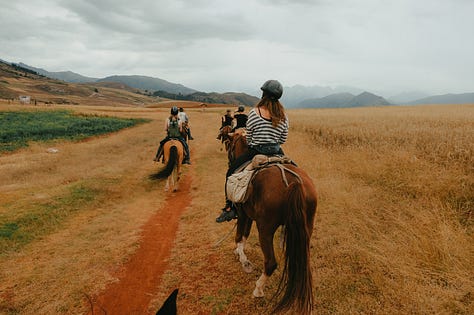

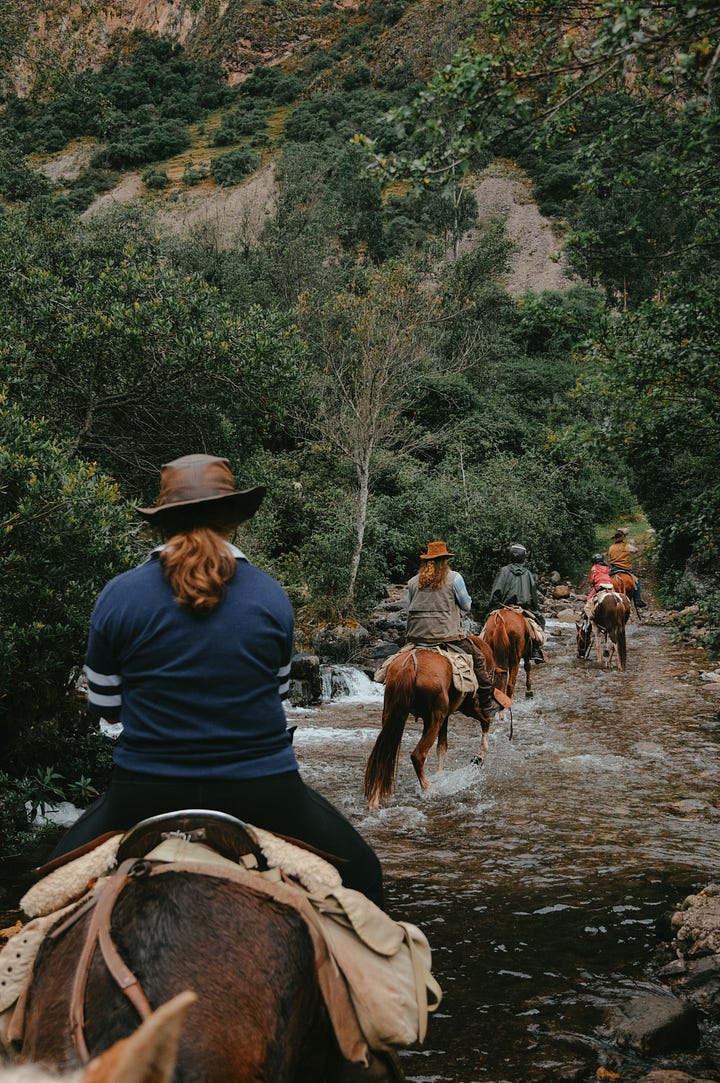

The countryside life may look idyllic, but the reality is that ranch life is intensely physical. The work never ends. One night, after a long day of riding, we were resting in bed after our shower when Karina knocked on the door. The hay truck had arrived, and they needed help wheeling in 260 bales of hay. I was assigned the easy task of counting the bales, while my compatriots labored with the wheelbarrows. Later that night, my fellow volunteer Sophie told me that at her family’s farm, they use tractors!
To be honest, it can be frustrating as a newbie to feel slow and behind everyone else. But my horse gal pals back home advised me to be gentle with myself. Over time, I slowly settled into the rhythm of things.
The routine of waking up early and going to bed early had a restorative effect on our bodies. We don’t realize how much being in a highly strung city environment affects us. Also, my neck aches miraculously disappeared! Our bodies are meant to be in movement, not hunched over a desk all day long.
12. Working with Horses and Children with Disabilities
One of my most fulfilling moments was helping out at the ranch’s equine therapy sessions.
I learned how to physically support the children while they were on horseback to ensure they didn’t slip off. We also did physical therapy exercises, where the child would pass me a hoop while trotting by on the pony.
It was a joy to witness the kids’ faces light up with glee as they gingerly groomed the pony and rode it around the stables, gaining more confidence in the process.
Learning to be present in the moment and in nature
This was an excerpt penned for Issue 10 of Lost Magazine from my 2022 Kazakhstan trip.
“Six hours on horseback. That’s how long our journey to the second Kolsay Lake and back would take, or an even longer eight-hour hike on foot. The night before, we had an intense discussion over dinner. e were warned that the journey would be dangerous, difficult, and unpredictable, especially for city dwellers like us with little experience with horses. In the end, seven out of nine of us decided to go. After all, horses were richly symbolic to Kazakhstan culture.
The next morning, we arrived at the starting point, saddled up, and were given a five-minute crash course.
To signal the horse to move, say “Chu” and give it a firm kick. When going uphill, lean forward; going downhill, lean back.
And off we went.
The journey began with our horses trotting along a heart-stoppingly narrow ridge as we climbed higher and higher. Far below us, Kolsay Lake was a picture of calm, a thread of sapphire blue surrounded by lush conifer and spruce trees. But we could barely take in the view, too focused on ensuring we didn’t fall off during the perilously steep ascents and descents.
My horse had a mind of its own. It often stopped to graze and stubbornly ignored my commands. When we reached the lake bank, instead of following the horse in front, it stopped to take a drink of water—one of the absolute no-nos.
Chaos ensued.
Our guide and Kazakh horseman yelled at me to take control as I frantically tried to yank the reins up. My horse stepped further into the waters—any deeper, and I might have plunged headfirst into the lake. But soon the rest of the horses joined in, and the horseman relented.
Our guide and Kazakh horseman yelled at me to take control as I frantically tried to yank the reins up. My horse stepped further and further into the waters — any deeper and I might have plunged headfirst into the lake. But then the rest of the horses joined in and the horseman relented.
We watched the horses silently drink their fill from the crystal-clear waters. It was a moment of pure magic.


Onward we went. The horseman decided that my horse was too temperamental and swapped it for a new one. This one was a lighter shade of brown and seemed gentler.
The trail took us through rushing streams, mountain forests dappled in golden sunlight, alpine meadows blanketed in wildflowers, and muddy paths lined with rocky boulders. Plodding steadily, it became a meditative exercise focused on my horse and the path ahead. I learned to calm myself, get used to its rhythm, and trust in its movements.
Each horse had its unique character. One was a “follower,” another liked to take its time going downslope, and was sensitive, kicking whenever others got too close. There was also a free spirit that loved to gallop whenever it had the chance.
I noticed that the horse in front often took the more challenging route, slipping and sliding. Thankfully, my horse was extra cautious, choosing a safer, less steep path for us. “Good job, buddy, clever boy,” I whispered to the horse and patted its mane encouragingly at regular intervals.
I learned the importance of leading at times and also trusting my horse’s sure-footedness, having the courage to let go and trust in the journey.
Others had more eventful rides. Our videographer had his camera bag caught in a branch, fell off his horse, and was dragged along the ground. He would have gone tumbling down the cliff if not for a bush that broke his fall. He emerged bruised and shaken. Another horse suddenly reared back on its hind legs. The horses seemed terrified of the Kazakh horseman—one slap or whistle from him, and they were on high alert, bolting forward.
After three hours, we made our way down a rocky cliff and emerged onto a clearing. In the distance, a sliver of blue appeared, like a mirage in the desert. Sensing the end was near, the horses started galloping at full speed.
The feeling of racing down the hill was surreal, wild, and free.
The lake emerged majestically before us, flanked by mountains and age-old trees, untouched and pristine. It was one of the most beautiful scenes I’d ever seen in my life. We had arrived at the fabled lake.
All in all, each time I’m out on a ride high up in the mountains abroad, I’m filled with a profound sense of awe, grateful for the opportunity to experience these amazing places the world has to offer on horseback.
14. Finding my tribe of horse girls
Since joining HERD, I’ve found myself surrounded by a community of fellow horse-crazy girls who shower me with positivity, love, and support. Together, we’ve shared so many wonderful experiences: celebrating Chinese New Year with a lohei/lohay for the horses, marking each other’s birthdays, enjoying sound bath healing, visiting each other’s homes and pets, going horse-riding in Malaysia, and even taking on the same overseas volunteer stints.
Having them in my life has been truly amazing.
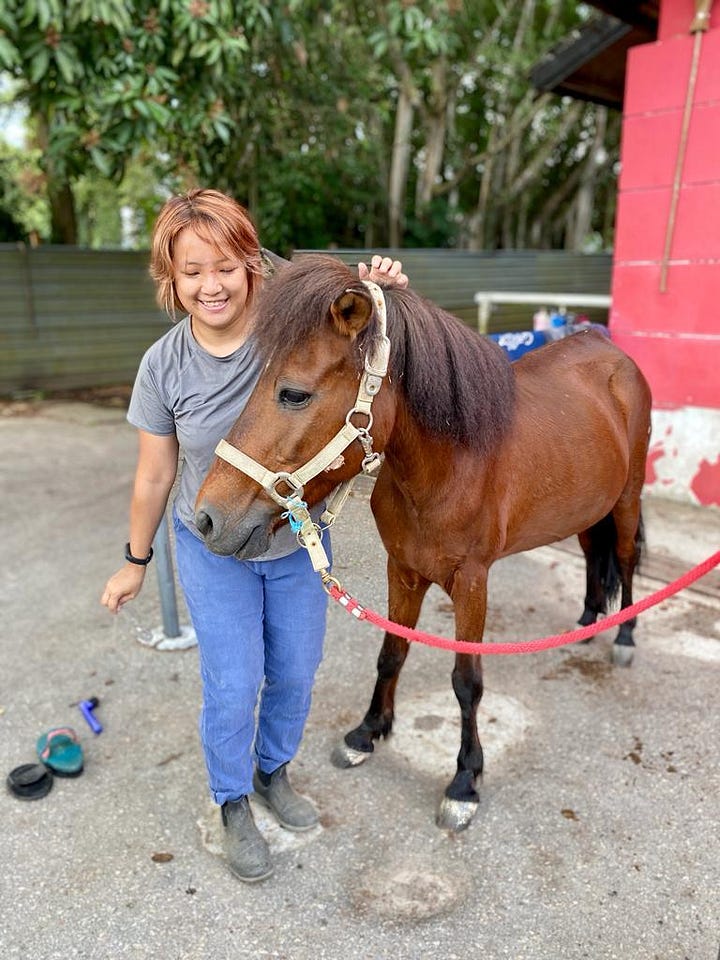



This coming October, I’ll be embarking on another volunteering stint at Heart Ranch in rural Hokkaido. I had the pleasure of featuring owner Rika Tatsukawa in an article for A Passion Thing’s Issue 10.
My tasks will include feeding the horses, cleaning the stalls, moving the horses across the ranch, capturing media of daily life at the ranch, creating content for social media, and assisting with the upcoming cafeteria and trailer houses. It’s a wild part of Japan that most people don’t get to see, and I’m both nervous and excited about the prospect.
Fellow horse gal Ting sums it best. She’s in Peru right now doing the same volunteer stint that I did!
“Horses are not just big puppies. they are true mirrors. They will gravitate towards certain people. Most people choose their dogs, but horses and cats absolutely choose their people.
There is no room for your ego when you work with horses. Leave it at the door. They’re incredibly sensitive and will pick up on it. Horses have always seen and known me for me, they know right away. I don’t need to explain. This world and most people get so tiring for me on many occasions. I don’t know why a born and bred city girl like me gravitates so much towards them, and them towards me. All I know is I exhale, lean in, and become incredibly present when I’m with them.
When they put their heads and lean into my chest, it’s the best part of my day. I’ll never trust a person a horse doesn’t trust (and if they obey you out of fear you can see it in their eyes). I give them as much love and do equine bodywork for them whenever I can. They’ve never gotten that at all and they work incredibly hard in such a harsh landscape. They heal parts of me. They say horses know a pure soul when they meet one. And in that, I take comfort.”
Or as another horse photographer writes, “When I was a child, I didn’t have much to say. Perhaps that’s why I was drawn to the horses. They didn’t have much to say either. We could enjoy each other’s company, without ever speaking a word. This has followed me into adulthood. To this day, I still find my happiest moments, when I’m sitting somewhere on this big, blue globe, surrounded by horses and nothing else but silence. There, with them, I’m enough. I’m not too quiet, too weird, too shy, too wrong, too much of anything. I’m precisely enough. If I could wish for you to take anything with you from my photos, it would be that you're enough. To some, my photos are merely of horses. To others, they're the confirmation they need that they're not alone. The evidence that others experience the world the same as they do.”
Most animal lovers would argue that every animal brings joy, but for me, the horse-riding lifestyle embodies a unique kind of zen. It’s a practice in being fully present, compassionate, and physically aware, fostering a profound sense of peace. My hope is that more people get to experience this deep connection with horses.
Me and darling Chico in Peru (May 2024)

